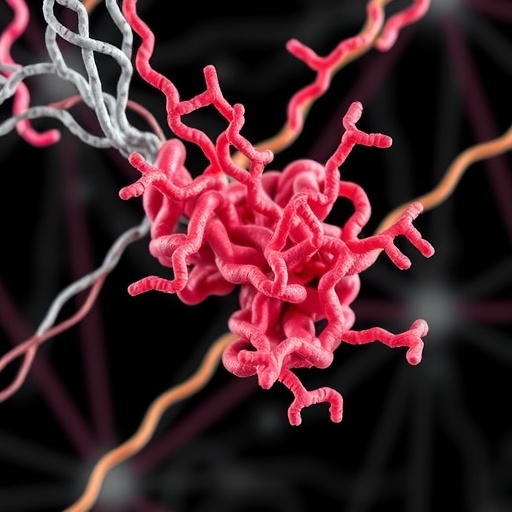In a groundbreaking advancement in the understanding of amyotrophic lateral sclerosis (ALS), recent research has uncovered a novel molecular mechanism involving muscle-derived microRNA that crucially influences motor neuron integrity. The study, led by Ionescu et al., reveals that miR-126, a small non-coding RNA molecule originating in muscle tissue, plays an essential regulatory role in maintaining the axonal local synthesis of TDP-43, a protein widely implicated in ALS pathology. This discovery provides significant insight into the intricate communication between muscles and neurons and opens new avenues for therapeutic intervention in neurodegenerative diseases marked by motor dysfunction.
ALS, a devastating neurodegenerative disorder characterized by progressive motor neuron degeneration and muscle wasting, remains without a cure or effective treatment to halt its progression. Central to ALS pathology is the protein TDP-43, whose aggregation and mislocalization are hallmark features observed in the majority of ALS cases. Until now, much of the research has focused on neuronal mechanisms, but this new study pivots attention towards peripheral contributions—specifically from skeletal muscle—and their impact on the neuromuscular junction (NMJ).
The NMJ, the vital synapse between motor neurons and muscle fibers, is critical for voluntary muscle contraction and effective motor control. Disruptions at the NMJ are an early indicator of ALS and precede widespread motor neuron death. The data presented illuminates how miR-126 derived from muscle fibers modulates local translation machinery within motor neuron axons, especially the synthesis of TDP-43, thereby maintaining NMJ integrity. This reveals a bi-directional molecular crosstalk that has been largely underestimated in ALS pathogenesis.
Using both in vitro and in vivo ALS models, the researchers meticulously demonstrated that miR-126 levels in muscle tissue have profound implications for axonal physiology. Reductions in muscle-derived miR-126 correlated with compromised TDP-43 local synthesis within motor neuron axons and subsequent NMJ dysfunction. Utilizing sophisticated imaging and molecular biology techniques, the study traced the pathway by which miR-126 exerts its regulatory effects, pinpointing specific targets and signaling cascades implicated in synaptic stability.
One of the most striking findings is the spatial precision with which miR-126 modulates TDP-43 expression in the axonal compartment, suggesting an intricate post-transcriptional control that’s critical for synapse maintenance. This local synthesis paradigm challenges the traditional belief that neuronal proteins are only synthesized in the soma before trafficking to distal axons. Instead, local translation appears to be a dynamic regulatory mechanism ensuring prompt and localized responses to synaptic demands, a process that muscle-derived signals like miR-126 can heavily influence.
Furthermore, the research uncovers that deficits in miR-126 contribute to a cascade of pathological events culminating in NMJ disruption. Specifically, the loss of miR-126 leads to diminished TDP-43 availability at synapses, destabilizing synaptic architecture and function. Given that NMJ degradation is among the earliest pathological features in ALS, these insights mark a pivotal turning point in understanding disease onset and progression.
Beyond the cellular and molecular findings, this work raises compelling questions about the broader roles of peripheral tissues in neurodegeneration. The notion that skeletal muscle actively communicates with motor neurons via microRNAs reframes the neurocentric view of ALS, implying that muscle pathology and nerve degeneration are intertwined processes. Therapeutic strategies might, therefore, benefit from targeting muscle tissue to restore miR-126 levels and rescue synaptic function.
Methodologically, the study exemplifies cutting-edge techniques including laser capture microdissection, high-resolution imaging, and localized translation assays, which collectively allowed precise dissection of the molecular interplay at the NMJ. These approaches provide a template for future investigations into localized RNA-mediated regulation in neural and muscular systems.
Moreover, the findings emphasize the delicate balance required for protein homeostasis in neurons, particularly in spatially distinct compartments such as axons. The regulation of TDP-43 synthesis by miR-126 underscores the vulnerability of this system in ALS, where disruptions in RNA metabolism are already known contributors to disease. This study elegantly links these events with external signals originating from muscle, broadening the framework of ALS pathophysiology.
In the clinical context, modulation of miR-126 presents a tantalizing therapeutic target. Restoring its levels in muscle tissue or mimicking its function could potentially stabilize NMJs, delay motor neuron degeneration, and extend functional motor capacity in ALS patients. However, translating these molecular insights into viable treatments will require extensive preclinical and clinical validation.
This research also sets the stage for exploring the role of other muscle-derived microRNAs in neurodegeneration and synaptic maintenance. The field may witness a surge in investigations aimed at decoding muscle-to-neuron signaling pathways and their implications in nervous system diseases beyond ALS, including spinal muscular atrophy and peripheral neuropathies.
Overall, this landmark study not only enriches the fundamental understanding of neuro-muscular communication in ALS but also heralds a paradigm shift in how neurodegenerative diseases can be approached, with attention increasingly directed at the interplay between various tissue types. The intricate dialogue mediated by miR-126 at the NMJ could symbolize a broader principle of peripheral influence on central nervous system pathologies.
Scientific communities and clinicians alike are eagerly anticipating further developments stemming from these insights, hopeful that they might pave the way for effective interventions and improved outcomes for ALS sufferers. The study underscores the complexity yet accessibility of biological systems where small RNA molecules, once thought to play minor roles, emerge as pivotal regulators in health and disease.
As the research community continues to unravel the layers of ALS pathology, the discovery of muscle-derived miR-126’s influence on TDP-43 local synthesis and NMJ integrity represents a beacon of hope. This breakthrough underscores the need for integrating multidisciplinary approaches to tackle neurodegeneration and exemplifies how detailed molecular investigations can reveal novel therapeutic horizons.
In conclusion, the work by Ionescu et al. exemplifies the evolving landscape of neurobiology, where nuances of cell-to-cell communication and post-transcriptional regulation are increasingly recognized as critical determinants of disease. The potent combination of muscle-derived miRNA regulation and local axonal protein synthesis expands our conceptual framework and offers promising new targets for therapeutic innovation in ALS and potentially other neurodegenerative disorders.
Subject of Research: The regulatory role of muscle-derived microRNA, specifically miR-126, in controlling TDP-43 local synthesis within motor neuron axons and maintaining neuromuscular junction integrity in ALS models.
Article Title: Muscle-derived miR-126 regulates TDP-43 axonal local synthesis and NMJ integrity in ALS models.
Article References:
Ionescu, A., Ankol, L., Ganapathy Subramaniam, A. et al. Muscle-derived miR-126 regulates TDP-43 axonal local synthesis and NMJ integrity in ALS models. Nat Neurosci (2025). https://doi.org/10.1038/s41593-025-02062-6
Image Credits: AI Generated





